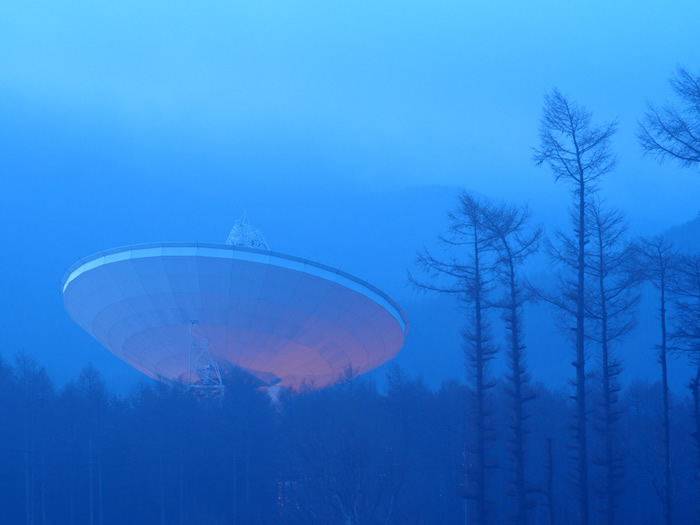The Season of Intent Listening Ends, the Nobeyama Radio Telescope Welcomes Spring
Photo・

| Date | Spring 2013 |
|---|---|
| Location | Nobeyama Radio Observatory |
| Photographer | Yutaka Iijima |
| Copyright | National Astronomical Observatory of Japan |
| Terms of Use | This image can be used without permission for research presentations, conferences, and school classes. In other cases, it cannot be used without prior permission. If you would like to use it, please fill out an application. In the case of commercial use, a photograph usage fee might need to be negotiated with the photographer, Mr. Yutaka Iijima. |
Spring, the Nobeyama 45 m Radio Telescope, wrapped in twilight. The giant parabolic antenna waits on weak radio waves coming from space. Radio waves are emitted by dilute, low temperature interstellar gas which can’t be seen by visible light. Observations to elucidate many mysteries of the Universe such as galactic motion and the birth of stars and planets continued through the winter. But the observation season ended in May. Radio wave observations are conducted during the dry winter season; maintenance is conducted during the summer.
A location favorable for radio astronomy, Nobeyama
Nobeyama Radio Observatory’s 45 m radio telescope observes the Universe through millimeter waves (radio waves with wavelengths close to a couple of millimeters.) After observations started in 1982, for a long time it played an important role as the world’s largest single-dish telescope observing this wavelength band*. It led radio astronomy by granting open use to the world’s astronomers. It has produced numerous results, from finding the black hole at the center of the galaxy to discovering many types of molecules in interstellar molecular clouds.
Radio waves in this waveband are largely absorbed by water molecules in the Earth’s atmosphere. Therefore, the number of sites suited to observations is limited in Japan, which is in the warm Temperate Zone.
Nobeyama (in Minamimakimura, Minamisaku, Nagano) where the observatory is located is a plateau spreading out at 1350 meter elevation at the foot of Mt. Yatsugatake. The highlands’ winter with little water vapor is suited for millimeter wave observations.
*Currently, the 100 m diameter GBT (Green Bank Telescope) in US is the largest with observation range up to millimeter wavelength.
(Author: Seiichiro Naito)